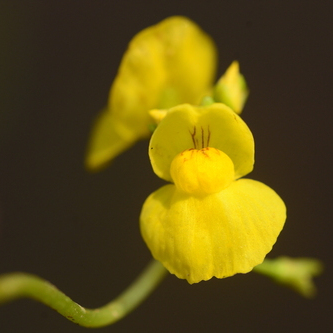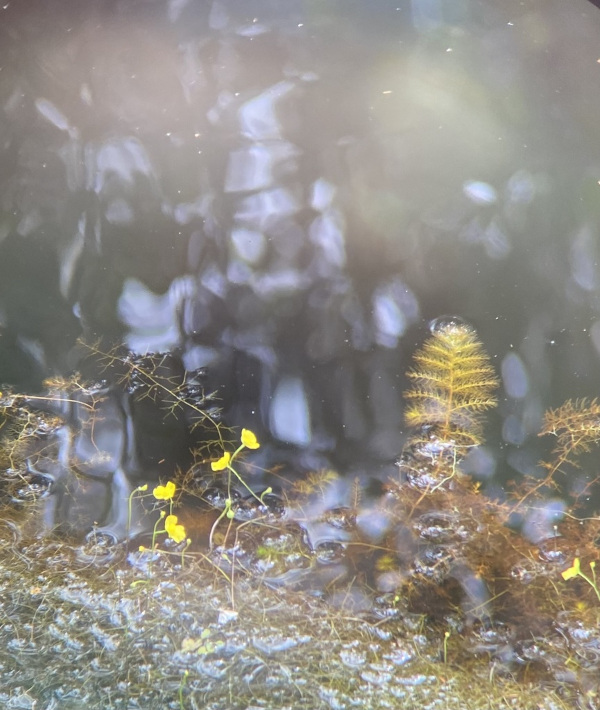October 07, 2025
The peatland swamps of Riau are home to one of the world’s fastest predators. It’s not a mammal, a reptile, a fish, an insect or even a bird — but a plant. Meet the golden bladderwort, commonly known as the golden bladderwort. This rootless aquatic species is full of surprises. It is a carnivore, catching its prey with suction-powered traps; but it also plays a vital role in nutrient cycling and water quality. In the Restorasi Ekosistem Riau (RER) landscape, this delicate yet deadly plant is a living indicator of healthy peatland hydrology.
Found everywhere from Bangladesh to Borneo and from the Eastern Himalayas down to Western Australia, golden bladderwort is the most common and widespread of all suspended aquatic plant species in Asia, growing from sea level all the way up to elevations of 2700 meters. Utricularia aurea is a member of the lentibulariaceae family, and one of 207 plant species identified in the RER project area. Its preferred habitat is standing water such as ponds, rice paddies, lakes and marshlands. This makes the peat swamp forests of Riau an ideal home for these flowering plants.
In this article we explore the golden bladderwort’s biology, its behavior, and the essential role it plays in our ongoing efforts to monitor and preserve Indonesia’s vital peatland ecosystems.

How it Looks: A Beautiful But Deadly Floating Flower
The distinguishing features of golden bladderwort are its flowers. These butter-yellow blooms grow on stems reaching to heights of around 15-25 cm, where they appear in groups of 10 short-lived bouquets. While the petals (corolla) are yellow in color, the inner surface of the upper and lower lips feature red stripes fanning out from the base.
Interestingly, the golden bladderwort has no roots. Instead of anchoring in soil, it drifts beneath the water surface. It features filaments or root hairs (called rhizoids) at the base of the main stem (called the peduncle), which it uses to absorb nutrients directly from the water.
The body is finely divided, thread-like, and green, aiding in buoyancy and photosynthesis. In the flowering season, it produces bright yellow, snapdragon-like flowers that emerge above the water surface on slender stalks – hence the name aurea (meaning ‘golden’). Its leaves are alternately arranged on the stem and are very finely divided into smaller leaf configurations around the stem.

How it Eats: Suction-Powered Traps
Utricularia aurea also has specialized structures called ‘utricles’ – small, air-filled sacs or cavities, similar to some species of seaweed. These tiny, bladder-like structures act as vacuum traps which catch prey by creating negative pressure inside. When small, aquatic organisms (like protozoa, water fleas, or mosquito larvae) brush against trigger hairs, the bladder sucks them in in less than a millisecond. The prey is then digested by enzymes secreted within the bladder.
This marvel of biomechanics and pressure differentials gives Utricularia aurea the quickest known movement in the plant kingdom and one of the fastest – if not the fastest – strikes in nature. In fact, it has been the subject of biomimetic engineering studies, inspiring designs for microfluidic devices and soft robotics – just one of the many ways in which the biodiversity of RER is continually updating our scientific knowledge.
This carnivorous behavior gives Utricularia aurea an edge over its competitors – it enables the plant to thrive in nutrient-poor waters where other aquatic plants would struggle.
Adaptations for Life in Peatland Ecosystems
Peatlands are typically acidic, waterlogged, and nutrient-poor ecosystems, which are especially low in elements like nitrogen and phosphorus. Utricularia aurea has evolved to not only survive, but thrive in exactly these conditions. If it were rooted to the substrate, it would be submerged during floods and unable to photosynthesize. By adapting to a life of floating, it has – quite literally – found a way to transcend these problems.
In addition, its finely divided leaves and efficient trapping system help it maximize nutrient intake without conventional photosynthetic trade-offs. The absence of roots is in fact a benefit – Utricularia aurea doesn’t rely on the nutrient-poor peat substrate, but instead draws nutrients from water and prey.
Ecosystem Services and Functional Role
Utricularia aurea provides a range of valuable services to the ecosystem in which it lives. The plant acts as a nutrient recycler, especially of nitrogen and phosphorus, which are otherwise scarce in peatland waters.
Moreover, by trapping and digesting small aquatic organisms (such as zooplankton and insect larvae), it helps to regulate microbial and invertebrate populations, preventing any one species from becoming overly successful and dominating the ecosystem. By consuming herbivorous zooplankton, the golden bladderwort also helps to regulate algal blooms.
Utricularia aurea provides a microhabitat for other small aquatic organisms, such as rotifers, copepods, and even some juvenile invertebrates. By occupying a niche between primary producers and carnivores, Utricularia aurea supports food web complexity.
Why it Matters to RER
The presence of Utricularia aurea in a wetland area will tell you a number of important things about that ecosystem. It typically signals clean, acidic, low-nutrient water with low turbidity, and also indicates undisturbed hydrology. In addition, because Utricularia aurea disappears when waters are overloaded with nutrients or sediment, its continued presence is a sign of low pollution and eutrophication levels.
Each of these characteristics makes Utricularia aurea a positive bioindicator species. Conversely, its decline or disappearance from peatland areas can also provide a useful warning sign, suggesting disturbances such as drainage or peatland drying, agricultural runoff, or encroachment from invasive species. With Utricularia aurea and other indicator species in RER, a healthy population often reflects the integrity of peat swamp hydrology and good water chemistry – key priorities in peatland restoration and conservation.
In RER’s peatland swamps, Utricularia aurea is both a beautiful example of botanical diversity and an indicator of the underlying health and resilience of the ecosystem. Its ability to thrive in low-nutrient, acidic waters is a testament to its evolutionary ingenuity, while its presence signals undisturbed hydrology and low pollution levels. As peatlands across Southeast Asia face increasing pressure, monitoring species like Utricularia aurea provides vital insights into changing conditions. Rootless, delicate, and astonishingly fast, the golden bladderwort is a small but powerful ally in understanding and protecting these vital wetland landscapes.